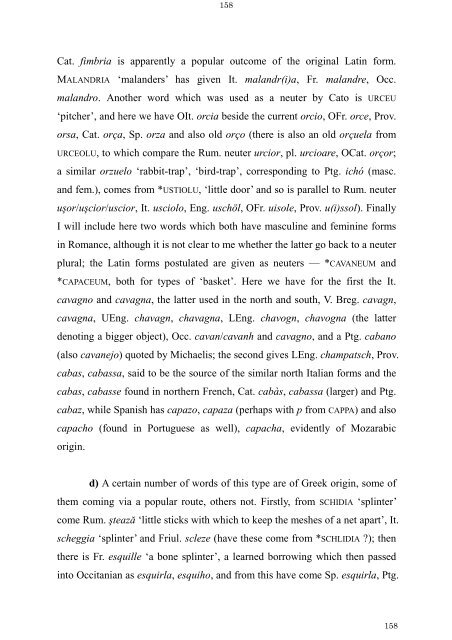The Latin Neuter Plurals in Romance - Page ON
The Latin Neuter Plurals in Romance - Page ON
The Latin Neuter Plurals in Romance - Page ON
Create successful ePaper yourself
Turn your PDF publications into a flip-book with our unique Google optimized e-Paper software.
158<br />
Cat. fimbria is apparently a popular outcome of the orig<strong>in</strong>al <strong>Lat<strong>in</strong></strong> form.<br />
MALANDRIA ‘malanders’ has given It. malandr(i)a, Fr. malandre, Occ.<br />
malandro. Another word which was used as a neuter by Cato is URCEU<br />
‘pitcher’, and here we have OIt. orcia beside the current orcio, OFr. orce, Prov.<br />
orsa, Cat. orça, Sp. orza and also old orço (there is also an old orçuela from<br />
URCEOLU, to which compare the Rum. neuter urcior, pl. urcioare, OCat. orçor;<br />
a similar orzuelo ‘rabbit-trap’, ‘bird-trap’, correspond<strong>in</strong>g to Ptg. ichó (masc.<br />
and fem.), comes from *USTIOLU, ‘little door’ and so is parallel to Rum. neuter<br />
uşor/uşcior/uscior, It. usciolo, Eng. uschöl, OFr. uisole, Prov. u(i)ssol). F<strong>in</strong>ally<br />
I will <strong>in</strong>clude here two words which both have mascul<strong>in</strong>e and fem<strong>in</strong><strong>in</strong>e forms<br />
<strong>in</strong> <strong>Romance</strong>, although it is not clear to me whether the latter go back to a neuter<br />
plural; the <strong>Lat<strong>in</strong></strong> forms postulated are given as neuters — *CAVANEUM and<br />
*CAPACEUM, both for types of ‘basket’. Here we have for the first the It.<br />
cavagno and cavagna, the latter used <strong>in</strong> the north and south, V. Breg. cavagn,<br />
cavagna, UEng. chavagn, chavagna, LEng. chavogn, chavogna (the latter<br />
denot<strong>in</strong>g a bigger object), Occ. cavan/cavanh and cavagno, and a Ptg. cabano<br />
(also cavanejo) quoted by Michaelis; the second gives LEng. champatsch, Prov.<br />
cabas, cabassa, said to be the source of the similar north Italian forms and the<br />
cabas, cabasse found <strong>in</strong> northern French, Cat. cabàs, cabassa (larger) and Ptg.<br />
cabaz, while Spanish has capazo, capaza (perhaps with p from CAPPA) and also<br />
capacho (found <strong>in</strong> Portuguese as well), capacha, evidently of Mozarabic<br />
orig<strong>in</strong>.<br />
d) A certa<strong>in</strong> number of words of this type are of Greek orig<strong>in</strong>, some of<br />
them com<strong>in</strong>g via a popular route, others not. Firstly, from SCHIDIA ‘spl<strong>in</strong>ter’<br />
come Rum. ştează ‘little sticks with which to keep the meshes of a net apart’, It.<br />
scheggia ‘spl<strong>in</strong>ter’ and Friul. scleze (have these come from *SCHLIDIA ?); then<br />
there is Fr. esquille ‘a bone spl<strong>in</strong>ter’, a learned borrow<strong>in</strong>g which then passed<br />
<strong>in</strong>to Occitanian as esquirla, esquiho, and from this have come Sp. esquirla, Ptg.<br />
158









